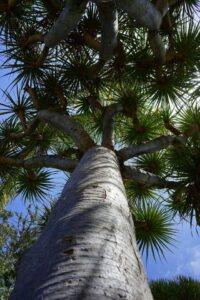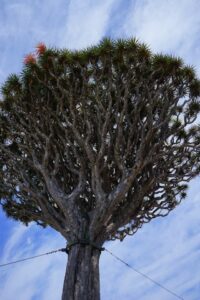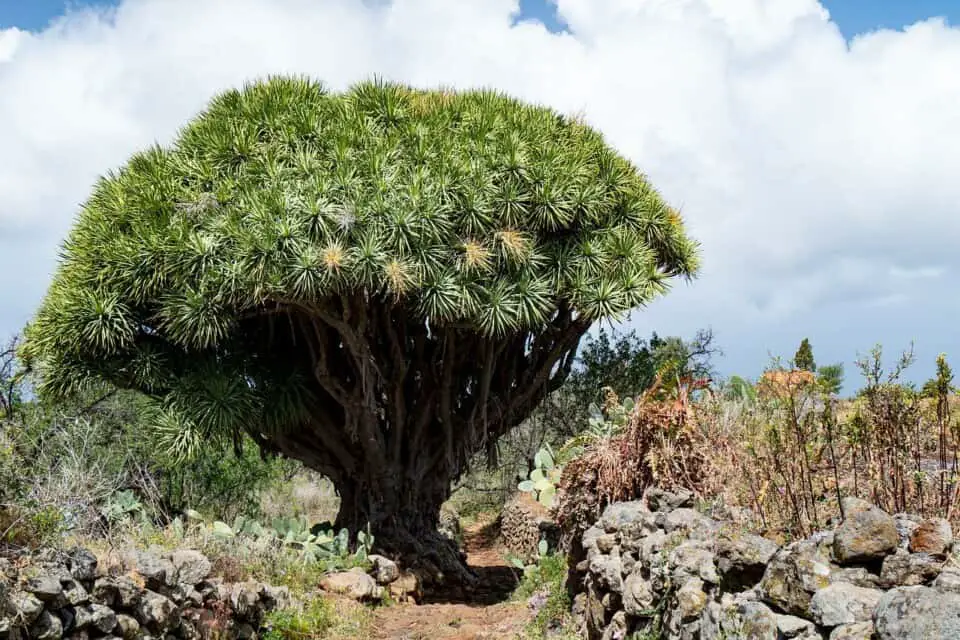Some links in the post are affiliate links and I get a commission from purchases made through some links found in the post.
I fell in love with my Dracaena Marginata so much that I wanted to learn everything about it.
And in doing so, I uncovered that it had many cousins because Dracaena is actually a genus. Other Dracaena plants are available, including Deremensis, Frangrans, and Sanderiana.
I was particularly interested in the Deremensis variety because it could grow up more than 10 feet when left to its means.
But of course, I did not have 10 feet of vertical space in my home, nor could I accommodate its breadth. So, I had to figure out if I could grow this or any other Dracaena outside.
And guess what? It is possible to grow the Dracaena outside. However, there is a caveat.
The Dracaena is quite sensitive to temperature fluctuations, if you live outside in hardiness zones 10 to 12 they can live outdoors but if not you cannot leave them outdoors all year round.
The dracaena is not very cold tolerant so will need to be wintered if you are in lower hardiness zones. Dracaenas do well in well-draining soil.
I will detail when you can grow the Dracaena outside, how to deal with winter, and how to protect the plant when you grow it outdoors.
I will also get into the essential plant care you must give your plant to give it a fighting chance against the weather elements.
Are Dracaenas Indoor or Outdoor Plants?
 The answer is both. In subtropical climates, the Dracaena works as an outdoor or indoor plant. And to understand why this is the case, we must focus on its natural habitat.
The answer is both. In subtropical climates, the Dracaena works as an outdoor or indoor plant. And to understand why this is the case, we must focus on its natural habitat.
The Dracaena comes from Australia, Southern Asia, and Africa. And what do these regions have in common? Even when the weather gets cold, it’s never freezing cold.
It can be unbearable, but it’s not so bad that plants cannot remain outdoors. And when you are growing the Dracaena outdoors in these regions, it does well.
But in areas where the summers and winters lie on the extreme sides, the Dracaena is best grown as an indoor plant.
In such a case, you can protect it from harsh temperature fluctuations, enabling it to thrive. So, the answer to this question depends on where you live, as I detail in the next section.
PS: When I mention Dracaena, I reference the entire genus. Of course, species will not have the exact requirements, but they are often not that far from each other.
You may also like: Dracaena vs Yucca
Where Is a Dracaena’s Natural Habitat?
Years back, I did not focus on plants’ natural habitats. Little did I know that such knowledge went a long way in helping gardeners replicate similar conditions for their plants.
For example, the Dracaena originates from Northern Australia, Southern Asia, and Africa, regions with warm climates for the most part.
And that means that for it to thrive, it must be in similar conditions. But this is not the best way to approach this. Instead, I recommend understanding each species’ native habitat.
Take the Dracaena Marginata as an example. It comes from Madagascar. As such, you should avail similar conditions. The Dracaena Fragrans hails from tropical Africa.
There are at least 170 Dracaena species, and a one-size-fits-all approach can set you back. So, while the natural Dracaena habitat is tropical, find out more about the specific Dracaena you want to introduce to your home.
You may also like: 5 great benefits of a dracaena for your home
Can a Dracaena Live Outside All Year Round?
And now, we come to a very critical question: Just how long can you leave the Dracaena outside? Let’s consider this based on regions.
If you live in northern Australia, Africa, or Southern Asia, the Dracaena would be fine all year round. After all, this is its natural habitat.
But what happens if you live in an area where extreme temperatures are the norm? Let’s consider your options:
Can I Put My Dracaenas Outside in America?
The Dracaena does best in USDA zones 10 to 12. These feature mild climates with high humidity and warm temperatures similar to what you would find in the Dracaena’s natural habitat.
The temperatures average 30 to 60 degrees Celsius (80 to 140 degrees Fahrenheit). As such, even when the cold months come along, the Dracaena does not suffer much of a hit and can continue growing outdoors.
On average, winter temperatures are about 30 degrees Fahrenheit, which are still ideal for gardening.
Such areas include:
- Hawaii,
- Southern Florida, and
- Southern California.
So, what happens if you live outside these zones? The good news is that you can still leave your Dracaena outside as it does well in warm temperatures about 65 degrees Fahrenheit.
And most zones hit such levels during the warmer months. But when winter starts and the temperatures start dropping, you will need to move the plant indoors to shelter it from frost.
Ideally, you should move the plant in the late fall to allow it to adjust to indoor conditions. Then once the last frost has passed, you can move the plant back outdoors.
Can I Put My Dracaenas Outside in the UK?
The weather in the UK is generally cool. And as such, the frost-free season lasts a long while between spring and the end of autumn.
But not all zones are suitable for the Dracaena. Just like the US has growing zones, so does the UK. But in this case, the RHS uses hardiness ratings. USDA zones 10 to 12 fall under ratings H1b to H3.
In these regions, the temperatures fall between 30 degrees Fahrenheit to about 60 on average. Thus, you can grow the Dracaena outside, and it would be okay.
Examples of such zones include:
- Isles of Scilly,
- Eastbourne
If you live outside these zones, you can still successfully grow a Dracaena, but you would need to do it indoors.
You may also like: How to save a dying dracaena marginata plant
Can Your Dracaena Live Outside in The Winter?
 The Dracaena does well in warm conditions where the temperatures average 65 degrees Fahrenheit and above.
The Dracaena does well in warm conditions where the temperatures average 65 degrees Fahrenheit and above.
However, some species like the Draco can survive temperatures as low as 50 degrees Fahrenheit.
Any lower than this, the plant suffers cold shock, stunting its growth, and even killing it in some cases. For this reason, most people prefer growing it as an annual. However, there is another way around this.
1) Growing hardy species
Not all Dracaena species suffer cold shock during winter. Some can even tolerate zones 7 to 8. So, if you want to grow a Dracaena outside, you can always go for such a species.
These will not require you to go out of your way to protect them. But that’s not always a given because winters can sometimes be harsher than expected.
2) Protecting your Dracaena
If you choose to leave your Dracaena outside, you will need to shelter it from cold winds as these can halt its growth.
You can add more mulch around its base and even cover it with a cloth or other windbreaker.
Also, move it to a more sheltered space where it does not get directly hit by drafts. For example, you can move it under a tree or between other plants where it can get some shelter.
3) Moving the Dracaena
If your Dracaena is not cold-hardy and you cannot protect it by providing it with cover, it’s advisable to dig it up and move it indoors. So, how do you go about this?
4) Don’t Wait until Winter to Move the Plant
This can send it into shock. Instead, dig around the plant in the late fall, exposing its roots. Do not touch the root ball. Leave it as it is and move the plant and the entire root ball into a potting mix.
5) Ensure the Potting Mix is Nutrient-Rich and Well-Draining
Ensure the pot has adequate drainage holes. You can then move the pot indoors, leaving it in a spot with sufficient light.
Now that the plant will not receive water from the rain, you will need to water it when the soil gets dry. Do not feed it during winter as this will not help the plant much. Instead, offer it water and light.
6) Move the Plant Outdoors when the Last Frost has Passed
Do this gradually by moving the plant outside for a few hours each day and returning it indoors. Add the exposure time in the days that follow before finally moving it outdoors full-time.
You can expect the plant to show signs of distress each time you move it to a different environment. So, to be safe, you can forego removing the plant from the container.
It will stress the roots less and allow it to adjust to the outdoor conditions much faster. It will also make it easier to move the plant indoors in the late fall.
Collecting Stem Cuttings
What if you do not want to move the Dracaena indoors because it will take up too much space? You have the option of propagating new Dracaena plants from the existing one.
You can leave the stem cuttings in a suitable container, and once the last frost has passed, you can plant them outdoors.
Your choice will, of course, depend on your situation. I prefer moving my plant around in its pot as this is more convenient.
You may also like: How Big Can Dracaena Get
Will Putting My Dracaena Outside Help It Grow?
Most plants do well outdoors but with the Dracaena, this is not always the case. This plant dies when exposed to very cold climates because it cannot tolerate frost.
Thus, the answer to this question depends on where you live. If you live in a suitable climate (USDA Zones 10 to 12), then yes, your plant will grow well outside.
But if your weather tends to be cold, this is not a good idea. You can move the dracaena outdoors when the temperatures are at least 65 degrees Fahrenheit.
But when they drop lower than this, you will need to move the plant indoors. I should add that some species can withstand lower ranges.
So, it’s best to understand what your specific Dracaena needs and see if your climate is up to the task.
How To Get Your Dracaena Used to Living Outside
There’s not much that goes into preparing the Dracaena for outdoor conditions. It will still need the same conditions it would require indoors. However, you should pay attention to:
Soil
The richer the soil is, the better it will be for your Dracaena. It’s always good to add some organic matter to boost the nutrient profile and increase soil drainage. You can use compost for this.
Feeding
The Dracaena will have access to more nutrients if you plant it directly in the ground. In this case, you can feed it every month with a houseplant fertilizer to boost its growth.
If you leave it in a pot, you will need to feed it twice a month during the growing seasons.
Light
 As much as the Dracaena is a tropical plant, it does not do well in direct sun. Ensure it gets dappled light where it can enjoy some shade to avoid leaf damage. But again, some species like the Draco can withstand direct sun exposure.
As much as the Dracaena is a tropical plant, it does not do well in direct sun. Ensure it gets dappled light where it can enjoy some shade to avoid leaf damage. But again, some species like the Draco can withstand direct sun exposure.
These are pretty much the same concerns you must address when growing the Dracaena indoors.
But there’s one more thing you need to note: your Dracaena will need time to acclimate. Please don’t move it out in one day.
Instead, expose the dracaena to the outdoors for a few hours each day, increasing the exposure time gradually until you move it out completely. And if frost appears, move it back indoors.
For more on dracaena light, we have an article on the light requirements for a dracaena marginata.
Where To Put Your Dracaena Outside
The Dracaena should be in well-draining soil. If you leave it in soggy soil, its roots will drown, and the plant will die. You should also consider exposure to sunlight.
Most Dracaena species do best in filtered light. But you will need to check what the specific species needs. And if you plan on leaving the plant outside year-round, you will need to locate it in a spot sheltered from direct winds.
Final Thoughts
It is possible to grow the Dracaena outdoors even if you do not live in USDA zones 10 to 12. However, you must be ready to move the plant indoors at the first sign of frost.
Moreover, if you notice drooping, browning, yellowing leaves, and stunted growth, moving the plant back indoors might be wise. Happy Gardening!

